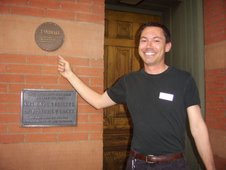What at difference a century makes. As Denver prepares to host the 2008 Democratic National Convention this August, it seems fitting to look at the city's preparation for our last and only other political convention: the Democratic National Convention of 1908!
Denver Mayor Robert Speer built a shining new City Auditorium that just happened to be dedicated on the day of his inauguration on June 1, 1908. When the convention opened in Denver in July 1908, William Jennings Bryan was the party's nominee. He later lost to William Howard Taft.

Although 2008's convention will be held in the Pepsi Center, the interior will surely bear some resemblance to the Auditorium's decoration from 1908. Pictures of George Washington, Andrew Jackson and Thomas Jefferson (presumably), dominate the walls. In addition, the rare 46 star flag hangs on the walls and rafters signifying the recent addition of Oklahoma to the union in 1907.

This picture shows the Auditorium rising from the corner of 14th and Champa. The building was constructed in record time, the cornerstone being laid in September 1907. The beautiful buildings to the rear of the Auditorium are unknown to me. What is apparent however is the residential character was forever altered with the construction of this building. The large homes and mansions along 14th Street began their swan song as the street became increasingly commercial in nature after 1910.

The home of Dr. Charles Denison stood at the corner of 14th and Champa, specifically 1402 Champa, opposite the new Auditorium. Many stately homes lined the street including the home of former governor John Evans at 14th and Arapahoe. It was demolished in 1910 to make way for the Denver Tramway Headquarters. That building today is known as the Hotel Teatro. To see what hideous building stands on the Denison grounds today, click here.

Denver, as capital of Colorado, has always been a place of visiation of politicians of all stripes. Here, President Woodrow Wilson and his wife Edith exit City Auditorium in 1919.
While the building still stands today, the decorative domes that dominated each corner were removed in the 1950s. The renovated building is known today as the Quigg Newton Denver Municpal Auditorium. But it more commonly associated with the Ellie Caulkins Opera House which is found within its walls. Here is a picture from DenverInfill showing the renovations taking place when the Ellie was being "installed".
For additional information on Blocks 100-105 that the City Auditorium is a part of, click here.
All black and white historic photos are from the Denver Public Library's Western History Collection.

4 comments:
Great job Shawn - I love reading these posts and learning about my new city!
Scott
Go Hillary!!!
Love, Squire Mom
Shawn,
Wonderful site.
Denver is alive with history and your site will help us all to appreciate and enjoy it more! Your love of our beautiful historical buildings shines through.
Joyce L. Stadig
Thanks for the rundown on the history of the Ellie. I worked on the design team for the renovation and I always wondered what they'll think if/when they renovate it again in 50 years. I have a few good shots of the renovation, including the empty building.
Post a Comment